
Kirrikin
Kirrikin is a uniquely Australian endeavour. Luxury accessories feature artworks of contemporary Indigenous Australian artists, showcased on stunning handcrafted silk and cashmere scarves; silk neckties, bow ties and pocket squares. Kirrikin's exclusive designs revolve around identity through exploring Aboriginal people, traditions, and their land. Spirited products that capture the essence of Australia.
Kirrikin is an Aboriginal word that roughly translates as "Sunday's best clothes". Kirrikin are proud to introduce this word to you, as it was a part of the original language recoded by missionaries visiting the Hunter Valley early in the 1820’s and is also part of Wonnarua language revitalisation.
Kirrkin personally sources every artist to carefully curate their ranges, having found some amazing artists and artwork emerging, with a whole genesis in style, message and intent. These artworks provide a perfect transition to fabric; it’s also very interesting to note how many of the artists had a dream that their work would ultimately end up on fabric.
Kirrikin is an Indigenous registered business with a percentage of each and every Kirrikin purchase directly returned to the featured Indigenous Australian artist involved in the design.
Kirrikin artists:
Kaye Lorraine White
Kaye is a respected elder from the Gararimarra skin group in the North-West Australian Pilbara region. She is 59 years old and a member of the stolen generation.
“My inspiration to paint came from my country of where my father was taken away as a small child. Being a descendant of the stolen generation - White Springs in the Pilbara of Western Australia. The surname White is my surname given to my father as a reminder of where he came from.
I love mixing colours and get my ideas from country in the Pilbara region and all over the world. When I paint I feel a strong connection to Banjima lands. I get pleasure from seeing the looks on people’s faces when they express their love of seeing my work of art, and the emotional connection they get from me telling the stories behind each one.
I started painting later on in my life and I always had a yearning to paint, so one day I started with one canvas and had a play with it and I have never looked back. It took me a while to let go of my paintings due to the love and emotional connection I had with everything single one of them. Then I realised I must let go and show the world what I’m capable of. Now I would love to see people wearing my art in every way shape and form, whether it be on a canvas on a wall in a home, office, gallery, on a gorgeous tie, T-shirts, dresses and so on. It provides me with opportunities and the desire to continue doing what I love - painting.”
Kaye has a love for blending colours and textures, drawing ideas from the surrounding environments in the Pilbara, while feeling a strong bond with the Banjima lands. Her technique is different to most using only a cottonbud & tooth pick to create the visual masterpiece. She has developed an individual striking style using deep vibrant colours to expressively connect with her roots. She views her works as liberating and uplifting.
Sheryl Hicks
Sheryl Hicks is the daughter of Robert Hicks. She was born in Wickham in 1974. She is a Ngarluma woman from the Roebourne area in the Pilbara region of Western Australia. She has five children and has been a teacher for 17 years. Sheryl began painting around 7 years ago. She enjoys being around other artists in her family and learning new techniques and styles. She paints a lot about water holes, rivers and wildflowers off her country and home in the Pilbara.
Shane Hansen
Yondee (Shane Hansen) – is a Noongar man from the South West of Western Australia – the traditional lands of the Noongar people. He was born in 1964 in Dumbleyung, 270 km south of Perth. The name Dumbleyung is derived from the Aboriginal word 'Dambeling' meaning large lake, and refers to the lake nearby which is the largest in south west WA. Yondee remembers this lake as a child and being told stories of the Wagal (rainbow snake) in its waters.
He was told about hunting and shown sand drawings by his father. Around the age of 10 he would travel and visit his aunties on the Swan River and would collect paper bark to help them in their art work. It was here that he started to learn about art from his older relatives who are known for their painting on paper bark.
He is an experienced and accomplished artist who is developing a way of working with sand and ochres to depict the stories and legends of his people. He also paints detailed figurative works based on mission life, hunting and animals. His works are abstract in their presentation but narrative in their content.
Yondee wishes to continue the stories passed on by his grandfather. These stories were learnt and then recreated as ground paintings where he feels the translation of his art into sand sends a message through imagery and attracts a different audience.
Yondee’s work has been exhibited throughout the world, and gained much attention, his work is striking in both composure and mood. Telling ancient stories in a contemporary way.
Made in Western Australia.

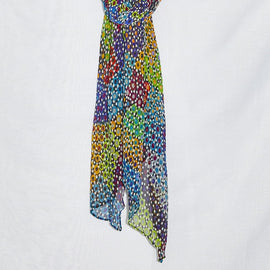
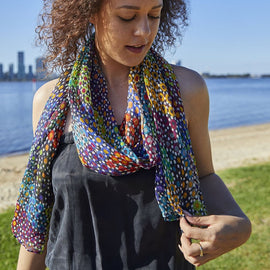
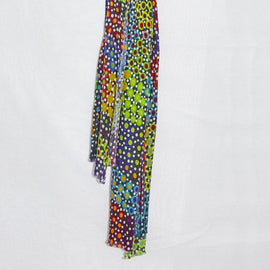
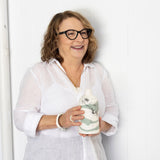
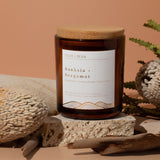
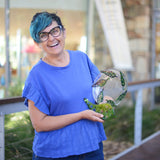
0 comments